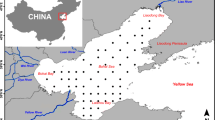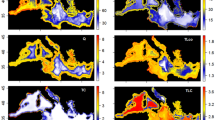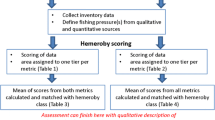Abstract
Purpose
The impact of human activities on marine environments is poorly addressed by the scope of life cycle impact assessment (LCIA). The aim of this study is to provide characterization factors to assess impacts of sea use such as fishing activities or seafloor destruction and transformation on the life support functions of marine ecosystems.
Methods
The consensual framework of land use for ecosystem services damage potential assessment was applied, according to the recent United Nations Environment Programme-Society for Environmental Toxicology and Chemistry (UNEP-SETAC) guidelines, using the free net primary production as a quality index of life support functions.
Results and discussion
The impact of shading, biomass removal, seafloor destruction, and artificial habitat creation on the available quantity of organic biomass for the ecosystem functioning was quantified at the midpoint level with a common unit (kg of organic carbon equivalent). It included effects of human interventions on both the ecosystem production potential and the stock of biomass present within the ecosystem. Characterization factors (CF) for biomass removal vary from 0.1 kgCeq kg−1 for seaweed to 111.1 kgCeq kg−1 for tunas, bonitos, and billfishes. CF for seafloor destruction range from 0.164 kgCeq m−2 for a temperate seagrass ecosystem to 0.342 kgCeq m−2 for an intertidal tropical rocky habitat.
Conclusions
This study provides an operational method in order to compute sea use impact assessment.




Similar content being viewed by others
Notes
In most papers, TL is expressed as a percentage and, following Pauly and Christensen (1995), the numerator of the equation is equal to \( {\mathrm{TE}}^{\mathrm{TL}-1} \). But this equation is only valid in the special case where TE = 10 %.
References
Agardy T, Alder J, Dayton P, Curran S, Kitchingman, et al (2005) Coastal systems. In: Hassan RM, Scholes R, Ash N (eds) Ecosystems and human well-being: current status and trends. Island Press, Washington, DC, p 513–549
Avadi A, Fréon P (2013) Life cycle assessment of fisheries: a review for fisheries scientists and managers. Fish Res 143:21–38
Behrenfeld MJ, Falkowski PG (1997) Photosynthetic rates derived from satellite-based chlorophyll concentration. Limnol Oceanogr 42:1–20
Bortone SA, Brandini FP, Otake S (2011) Artificial reefs in fisheries management. CRC Press, Boca Raton
Cahoon LB (1999) The role of benthic microalgae in neritic ecosystems. In: Ansell AD, Gibson RN, Barnes M (eds) Oceanography and marine biology, an annual review, vol. 37. Taylor & Francis Ltd, London, p 47–86
Charpy-Roubaud C, Sournia A (1990) The comparative estimation of phytoplanktonic, microphytobenthic and macrophytobenthic primary production in the oceans. Mar Microb Food Webs 4:31–57
Coll M, Libralato S, Tudela S, Palomera I, Pranovi F (2008) Ecosystem Overfishing in the Ocean. PLoS ONE 3(12):e3881. doi:10.1371/journal.pone.0003881
Collie JS, Hall SJ, Kaiser MJ, Poiner IR (2000) A quantitative analysis of fishing impacts on shelf‐sea benthos. J Anim Ecol 69:785–798
Cusson M, Bourget E (2005) Global patterns of macroinvertebrate production in marine benthic habitats. Mar Ecol Prog Ser 297:1–14
Dernie KM, Kaiser MJ, Warwick RM (2003) Recovery rates of benthic communities following physical disturbance. J Anim Ecol 72:1043–1056
Díaz S, Tilman D, Fargione J, Chapin FI, Dirzo R, et al (2005) Biodiversity regulation of ecosystem services. In: Hassan R, Scholes R, Ash N (eds) Ecosystems and human well-being: Current state and trends: Findings of the condition and trends working group. Island Press, Washington, p 297–329
Duarte CM, Chiscano CL (1999) Seagrass biomass and production: a reassessment. Aquat Bot 65:159–174
Efole Ewoukem T, Aubin J, Mikolasek O et al (2012) Environmental impacts of farms integrating aquaculture and agriculture in Cameroon. J Clean Prod 28:208–214
Emanuelson A, Ziegler F, Pihl L et al (2012) Overfishing, overfishedness and wasted potential yield: new impact categories for biotic resources in LCA. Saint-Malo, France, pp 511–516
FAO (2010) Part 1: World review of fisheries and aquaculture. State World Fish. Aquac. 2010. FAO, Rome, pp 3–89
Froese R, Pauly D (eds) (2012) FishBase. World Wide Web electronic publication. http://www.fishbase.org/
Frontier S, Pichod-Viale D (1991) Ecosystèmes: structure, fonctionnement, évolution. Collection d’écologie 21. Masson, Paris
Gattuso J-P, Gentili B, Duarte CM et al (2006) Light availability in the coastal ocean: impact on the distribution of benthic photosynthetic organisms and their contribution to primary production. Biogeosciences 3:489–513
Graham M (1935) Modern theory of exploiting a fishery, and application to North Sea trawling. ICES J Mar Sci 10:264–274
Green EP, Short FT (2003) World atlas of seagrasses. University of California Press, Berkeley
Grossman GD, Jones GP, Seaman WJ (1997) Do artificial reefs increase regional fish production? A review of existing data. Fisheries 22:17–23
Guinée J, Gorrée M, Heijungs R, Huppes G, Kleijn R, De Koning A, Van Oers L, Sleeswijk A, Suh S, Udo de Haes H, De Bruijn H, Van Duin R, Huijbregts M (2001) Life cycle assessment—an operational guide to the ISO standards; part 1: LCA in perspective. CML, Bureau B&G, Delft University of Technology, Netherlands, p 11
Halpern BS, Walbridge S, Selkoe KA et al (2008) A global map of human impact on marine ecosystems. Science 319:948–952
Henriksson PJG, Guinée JB, Kleijn R, de Snoo GR (2012) Life cycle assessment of aquaculture systems—a review of methodologies. Int J Life Cycle Assess 17:304–313
Hiddink JG, Jennings S, Kaiser MJ et al (2006) Cumulative impacts of seabed trawl disturbance on benthic biomass, production, and species richness in different habitats. Can J Fish Aquat Sci 63:721–736
Hiscock K, Jackson A, Lear D (1999) Assessing seabed species and ecosystems sensitivities. Existing approaches and development. Report to the Department of the Environment Transport and the Regions from the Marine Life Information Network (MarLIN). Plymouth: Marine Biological Association of the UK. (MarLIN Report No.1). October 1999 edition. http://www.marlin.ac.uk/PDF/MarLINReport1.PDF
Inger R, Attrill MJ, Bearhop S et al (2009) Marine renewable energy: potential benefits to biodiversity? An urgent call for research. J Appl Ecol 46:1145–1153
Jerbi MA, Aubin J, Garnaoui K et al (2011) Life cycle assessment (LCA) of two rearing techniques of sea bass (Dicentrarchus labrax). Aquac Eng 46:1–9
Johnson MR, Boelke C, Chiarella LA, Colosi PD, Greene K, Lellis K, Ludemann H, Ludwig M, McDermott S, Ortiz J, Rusanowsky D, Scott M, Smith J (2008) Impacts to marine fisheries habitat from nonfishing activities in the Northeastern United States. NOAA Technical Memorandum NMFS-NE-209. http://nefsc.noaa.gov/publications/tm/tm209/
Koellner T, de Baan L, Beck T et al (2013) UNEP-SETAC guideline on global land use impact assessment on biodiversity and ecosystem services in LCA. Int J Life Cycle Assess 18:1188–1202
Langlois J, Fréon P, Steyer J-P et al (2014a) Sea use impact category in life cycle assessment: state of the art and perspectives. Int J Life Cycle Assess 19:994–1006
Langlois J, Fréon P, Delgenes JP et al (2014b) New methods for impact assessment of biotic-resource depletion in LCA of fisheries: theory and application. J Clean Prod 73:63–71
Libralato S, Coll M, Tudela S et al (2008) Novel index for quantification of ecosystem effects of fishing as removal of secondary production. Mar Ecol Prog Ser 355:107–129
Longhurst AR (2007) Ecological geography of the sea. Academic, San Diego
MacIntyre HL, Geider RJ, Miller DC (1996) Microphytobenthos: the ecological role of the “secret garden” of unvegetated, shallow-water marine habitats. I. Distribution, abundance and primary production. Estuaries 19:186
Mateo MA, Cebrián J, Dunton K, Mutchler T (2006) Carbon flux in seagrass ecosystems. Seagrasses Biol. Ecol. Conserv. Springer, Netherlands, pp 159–192
McCarthy, EM (2004) International regulation of underwater sound - establishing rules and standards to address ocean noise pollution. Springer US. doi:10.1007/b118284
Michelsen O (2007) Assessment of land use impact on biodiversity. Int J Life Cycle Assess 13:22–31
Mila i Canals (2003) Contributions to LCA methodology for agricultural systems. Site-dependency and soil degradation impact assessment. University of Barcelona
Mila i Canals L, Bauer C, Depestele J et al (2007a) Key elements in a framework for land use impact assessment within LCA. Int J Life Cycle Assess 12:5–15
Mila i Canals L, Romanya J, Cowell S (2007b) Method for assessing impacts on life support functions (LSF) related to the use of “fertile land” in life cycle assessment (LCA). J Clean Prod 15:1426–1440
Moura A (2010) Experimental study of the macrobenthic colonisation and secondary production in the artificial reefs of Algarve coast. PhD thesis Universidade do Algarve. p 161
Nilsson P, Ziegler F (2007) Spatial distribution of fishing effort in relation to seafloor habitats in the Kattegat, a GIS analysis. Aquat Conserv Mar Freshwat Ecosyst 17:421–440
Núñez M, Antón A, Muñoz P, Rieradevall J (2013) Inclusion of soil erosion impacts in LCA on a global scale: application to energy crops in Spain. Int J Life Cycle Assess 18:755–767
Oregon State University (2010) Ocean productivity. http://www.science.oregonstate.edu/ocean.productivity/custom.php. Accessed 1 Feb 2012
Pauly D, Christensen V (1995) Primary production required to sustain global fisheries. Nature 374:255–257
Pauly D, Alder J, Bakun A, Heileman S, Kock k-H (2005) Marine fisheries systems In: Hassan RM, Scholes R, Ash N (eds) Ecosystems and human well-being: current status and trends. Island Press, Washington, p 513–549
Pelletier NL, Ayer NW, Tyedmers PH et al (2007) Impact categories for life cycle assessment research of seafood production systems: review and prospectus. Int J Life Cycle Assess 12:414–421
Pickering H, Whitmarsh D (1997) Artificial reefs and fisheries exploitation: a review of the “attraction versus production” debate, the influence of design and its significance for policy. Fish Res 31:39–59
Ricciardi A, Bourget E (1999) Global patterns of macroinvertebrate biomass in marine intertidal communities. Mar Ecol Prog Ser 185:21–35
Schaefer MB (1954) Some aspects of the dynamics of populations important to the management of the commercial marine fisheries. Bull IATTC 1:27–56
Vázquez‐Rowe I, Hospido A, Moreira MT, Feijoo G (2012) Best practices in life cycle assessment implementation in fisheries. Improving and broadening environmental assessment for seafood production systems. Trends Food Sci Technol 28(2):116–131
Weidema BP, Lindeijer E (2001) Physical impacts of land use in product life cycle assessment. Department of Manufacturing Engineering and Management, Technical University of Denmark, Lyngby, p 52
Acknowledgments
This work benefited from the support of the French National Research Agency (WinSeaFuel ANR-09-BIOE-05). The authors also thank O. Negri, N. Devaux, and E. Crochelet for their advice on GIS data analysis and L. Duc Anh for his remark on the trophic transfer equation.
Author information
Authors and Affiliations
Corresponding author
Additional information
Responsible editor: Shabbir Gheewala
Electronic Supplementary Material
Below is the link to the electronic supplementary material.
11367_2015_886_MOESM1_ESM.docx
Additional information on the values used to calculate values of NPP and standing biomass, the accuracy of these values, maps of pelagic NPP by type of marine provinces, tables summarizing the characterization factors. (DOCX 128 kb)
Rights and permissions
About this article
Cite this article
Langlois, J., Fréon, P., Steyer, JP. et al. Sea use impact category in life cycle assessment: characterization factors for life support functions. Int J Life Cycle Assess 20, 970–981 (2015). https://doi.org/10.1007/s11367-015-0886-7
Received:
Accepted:
Published:
Issue Date:
DOI: https://doi.org/10.1007/s11367-015-0886-7




